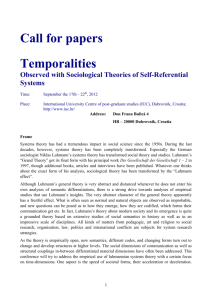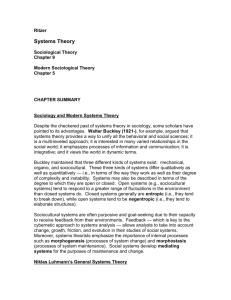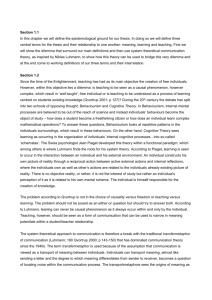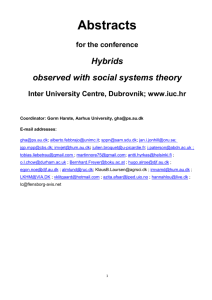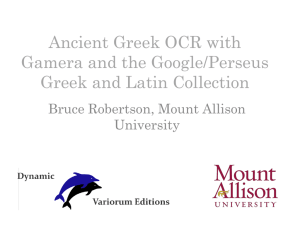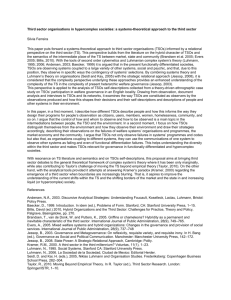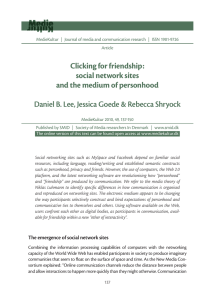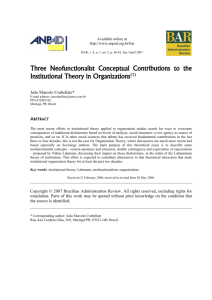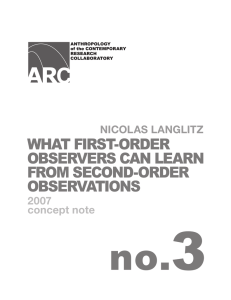Against a Systemic Legal History
advertisement
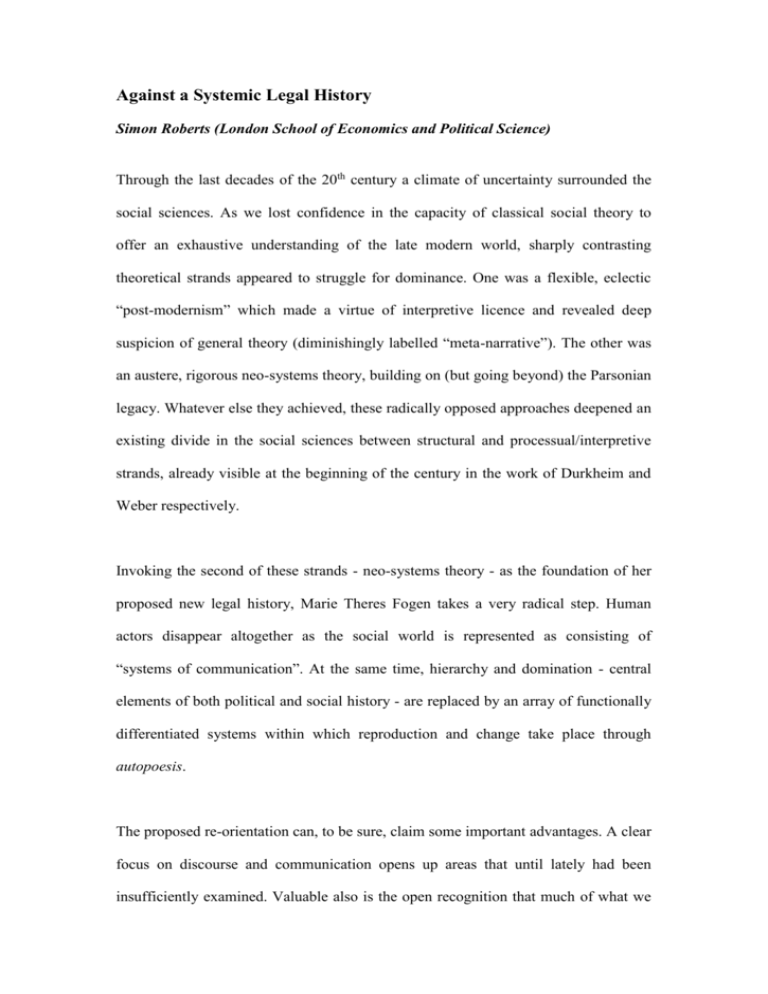
Against a Systemic Legal History Simon Roberts (London School of Economics and Political Science) Through the last decades of the 20th century a climate of uncertainty surrounded the social sciences. As we lost confidence in the capacity of classical social theory to offer an exhaustive understanding of the late modern world, sharply contrasting theoretical strands appeared to struggle for dominance. One was a flexible, eclectic “post-modernism” which made a virtue of interpretive licence and revealed deep suspicion of general theory (diminishingly labelled “meta-narrative”). The other was an austere, rigorous neo-systems theory, building on (but going beyond) the Parsonian legacy. Whatever else they achieved, these radically opposed approaches deepened an existing divide in the social sciences between structural and processual/interpretive strands, already visible at the beginning of the century in the work of Durkheim and Weber respectively. Invoking the second of these strands - neo-systems theory - as the foundation of her proposed new legal history, Marie Theres Fogen takes a very radical step. Human actors disappear altogether as the social world is represented as consisting of “systems of communication”. At the same time, hierarchy and domination - central elements of both political and social history - are replaced by an array of functionally differentiated systems within which reproduction and change take place through autopoesis. The proposed re-orientation can, to be sure, claim some important advantages. A clear focus on discourse and communication opens up areas that until lately had been insufficiently examined. Valuable also is the open recognition that much of what we see around us cannot be explained entirely in terms of the intentional constructions of human agents, less still as marking the skilled achievements of those in power. Salutary too is the reminder that messages do not retain a pristine state under transmission - particularly as they pass from one region of specialised discourse to another, or down the chain of some hierarchy of command. Nevertheless, it may be argued that all of this can be - indeed has been - achieved without suffering the constraints which resort to systems theory imposes upon our understanding of the social world. Despite the contemporary fashionable status of neo-systems theory, and the fact that it has attracted as its advocates some of the ablest legal scholars in Europe, legal historians should remain very cautious about accepting the promises held out. There are a number of reasons why this way of looking at the world, with its immediate origins in engineering and the natural sciences, might not deliver for the historian with an evolutionary turn of mind. Niklas Luhmann, the principal exponent of neo-systems theory in the social sciences, made grandiose claims about the importance of “law” from an early point in his career, at the same time asserting its universality. Remember the words with which he opened his Rechtssoziologie of 1972: "All collective human life is directly or indirectly shaped by law. Law is, like knowledge, an essential and all-pervasive fact of the human condition" (English trans. l985: l). Marie Theres Fogen shares this position, claiming that law (Recht) is “everywhere”. Furthermore, “there has been and there still is law without jurisprudence, even law without laws and without legal doctrine and without lawyers” (at para. 6). It is not at all clear what either scholar means here, and arguably both allowed their enthusiasm to run away with them in making these claims! We can readily agree that there can be regularity in the social world without “the King”, without a differentiated legal order, and that human societies have “always” revolved round normative understandings (by definition, involving some sort of binary coding marking approval/disapproval). But the presence of a sense of “legality” is arguably by no means universal and best seen as arriving somewhere along the line in the course of those very processes of differentiation which Luhmann’s work so challengingly addresses. Here it is perhaps not misanthropic to suggest that the search upon which Fogen urges us to re-embark for a general conception of law “not dependent on historically changeable contingencies” (para. 6) - has long proved extremely problematic. Turning back to the matter immediately at hand, it is important to remember that Luhmann had his eye firmly upon understanding a particular historical moment in formulating his theory. Although (like Marx, Durkheim and Weber before him) he drew in a broad evolutionary trajectory, he was (like them) concerned principally with the “modernity” of his own time. So his framework is closely tailored to what he identifies as “functionally differentiated society”, the phase at which discrete specialized regions have developed in society, each with their own distinctive discourses (“media of communication”). Earlier phases – covering precisely those formations that historians will presumably focus upon – are very hazily sketched in and relatively poorly theorized. The theory that Luhmann developed may be difficult to apply, even of little interest, outside a context in which advanced system differentiation is present. The radical conception of system “closure” which Luhmann postulated may also present barriers for legal historians to surmount in the use of his theory. A sense of some problems here may be gained from Teubner’s attempts to embrace “legal pluralism” (1992; 1997).1 Anxious to pursue the pluralist project, he at once found himself struggling under the constraints of a systems theory perspective hostile to "interdiscursivity" - indeed, one which asserts normative closure, radically at odds with the theme of "permeability" underpinning major work in the pluralist field (eg. Moore (1973); Griffiths (1986); Merry (1988)). Luhmann's early formulations insist upon normative closure, requiring us to see movement in the environment of a system as `turbulence' or `noise', bringing about an internally shaped response from the system. While this gets away from the difficulties inherent in the older generation of systems theory, which portrayed movement across the boundaries of systems in terms of `input' and `output'- suggesting a rather rigid, arthritic process under which a message transmitted in one region would be received more or less intact in another - the new account is impoverished in another way. The metaphors of `turbulence' and `noise' imply a restricted view of the interchange and penetration taking place across boundaries. The obvious image of the pressurised aircraft passing through adverse weather conditions, with everyone inside getting shaken up but no one falling out and nothing getting `in' from outside, conveys too little. Teubner recognises this: "the concept of structural coupling developed in General Systems Theory is not complex enough to cope with the special problems of law and society ... mere perturbation does not sufficiently grasp the specific closure/openness of social sub-systems" (1992:1447). He proposes an apparently small but enormously significant re-formulation. "In order 1 For Teubner: "Legal pluralism is then defined no longer as a set of conflicting social norms in a given social field but as a multiplicity of diverse communicative processes that observe social action under the binary code of legal/illegal." (1992: 1451). to do justice to interdiscursive relations ... I suggest replacing perturbation with productive misreading. In legal pluralism the legal discourse is not only perturbated by processes of social self-production, but law productively misreads other social discourses as 'sources' of norm production" (ibid). This certainly seems to do the trick. While messages are inevitably transformed in their transition from one discourse to another, `something' passes across the boundary, if in garbled form. Teubner's revision retains the important message, central to Luhmann's earlier formulation, to the effect that `change' in the context of `contact' needs to be thought about in terms of internally shaped responses - each `system' will respond to its `environment' in its own way. But the new way of putting things recognises that a concept of normative closure diminishes too radically the nature of the interchange that takes place. Our experience of the lived-in world strongly encourages us to adopt some notion of `permeability', even in the context of the system differentiation characteristic of modernity. Outside that context, this recognition is imperative. Anyone sitting in the local courts of the post colonial world will pick up snatches of discourse, transformed in the course of their absorbtion into the vernacular, but revealing unmistakably their biblical or legal provenance. We should not seek to disguise the magnitude of this shift in theoretical terms. A radical insistence on closure had been, alongside a determination to locate the social in systems of communication, one of the central features of neo-systems theory as presented by Luhmann and his disciples. How much is left once this core element is given up? And how far would Luhmann have gone along with this re-presentation? Arguably, he had already moved some way towards it in his recognition of the question: "to what extent the theoretical apparatus of the legal system and of legal dogmatics in particular is capable of perceiving and taking into account autopoietic systems in its environment" (1992b:393). Marie Theres Fogen’s project of a specifically legal history obviously requires a clear line to be drawn, for analytic purposes, between “legal” communications and those of other social practices. Both Luhmann and Teubner have given close attention to this problem of definition and come up with a single answer. For Luhmann: “When legal systems become differentiated as special functional systems of society, this occurs on the basis of a special binary code, by which the operations of this system are oriented (1992a:146). This code, in which legal communications are expressed, is “the binary code of legal/illegal”. Emphasising the importance of being “meticulous in defining the legal proprium”, Teubner justifies this “privileged delineation” as follows: “...this is the line which the discursive practice of law draws between itself and its environment. If we are interested in a theory of law as a self-organising social practice, then it is not up to the arbitrary research interests to define the boundaries of law. Boundaries of law are one among many structures that law itself produces under the pressure of its social environment. And only a clear delineation of the self-produced boundaries of law can help to clarify the interrelations of law and other social practices." (1992: 1452). Given that, for Luhmann and Teubner, this binary code organizes the autopoetic reproduction of law in functionally differentiated society, this self-description of law seems well enough suited as a definition for their purpose. But it is less clear what useful application it might have beyond the context of functionally differentiated society. Fogen nonetheless comes close to adopting it, proposing "communication oriented around the antinomies of lawful and unlawful / right and wrong" (page 2, para 6). It is not difficult to forecast the definitional struggles likely to surround the identity of the binary coding which Fogen proposes should mark the legal domain. With her extension of the code to embrace “right and wrong”, it ceases to be clear which "systems" might be seen as observing this code. Luhmann himself rejected this formulation as “too broad” (Luhmann, 1992a:146). Fogen’s formulation also imports an explicit moral evaluation into the code, something that Luhmann was anxious to avoid. What is it about the code, under Fogen’s formula, that distinguishes it from other categories of normative discourse? While normative understanding (ie, that marked by the sign of "ought"), by definition, revolves around some sort of binary coding - we must presumably be talking about something more than the element approved/disapproved inherent in any mode of normative communication. Is it the imperative, categorical nature of the opposition, a feature apparently closely bound up with law's provenance as an instrument of command - a link which Luhmann and his colleagues had apparently ruthlessly demolished? Has it to do with the nature and availability of sanctions? Do we see the code as circumscribed by the particular linguistic forms within which the opposition is expressed in state law? Both Luhmann and Teubner make it clear that they see a range of normative systems falling within this definition - "the binary code legal/illegal is not peculiar to the law of the State" (Teubner, 1992: 1451). But can it have application outside the bounds of functionally differentiated society, within which Luhmann's schema was conceived? To be useful for Fogen’s purposes it must have. Her difficulty is that the very conception of legality upon which the original opposition rests seems specific, if not to a particular culture, at least to functionally differentiated society. Does the reformulation she has chosen surmount that without dissolving the clear delineation of law - as opposed to other normative orders – that she is anxious to achieve? In the context of the broad comparative, evolutionary project that Fogen proposes, there may also be a methodological concern at the manner in which she reaches her delimitation of law for analytic purposes. No one would wish to fault the concern which she shares with Luhmann and Teubner - to listen to law's own account of itself. An understanding of the sharply differentiated arrangements found in the contemporary West can properly begin with a recovery of “the system’s” self-understandings and descriptions, with lawyers’ own accounts of their conventions of communication (and lawyers themselves lay claim to systemic qualities for their arrangements –“the legal system”; “the machinery of justice”, etc). But it is another matter to accept modern law's self-description, law's "folk" or "native" view of itself, as the basis for marking out scientifically the enlarged legal domain contemplated by Fogen’s proposed evolutionary panorama. It is one thing to be attentive to the folk categories within a particular social field, another to co-opt them in defining the larger region of enquiry.2 Overall, we must wait and see what kind of legal history Marie Theres Fogen’s resort to neo-systems theory produces.3 But my own position remains that we should not too readily acknowledge “the exhaustion of the paradigm of modernity” (Santos, 1995) or rush to proclaim the obsolescence of the theoretical resources developed in those now This concern is equally applicable to Teubner’s (1992) attempt to embrace “legal pluralism”. Her position is patently eclectic as she writes of communications in a quite “unsystemic” way. For example: “In order to become communication, information has to be conveyed, either in the form of oral or written language, or through actions, gestures, sounds or images. Only once the message has reached others, and has been "understood" - or misunderstood - by them, does communication become a meaningful social event that can be followed up by further communication” (para. 6). 2 3 apparently far off days. Fogen’s rejection of a multi-dimensional approach takes us away from the very fruitful efforts of scholars like Bourdieu (1977) and Giddens (1984) to relate human action (“practice”) to the conditional environment (“structure”) and distracts from continuing attempts to bridge long-standing divisions in the social sciences. The evolution of differentiated “legal” orders and an ideology of “legalism” have been closely associated, in widely separate cultural contexts, with the human struggles associated with the establishment of kingship and the nation state. These processes are equally intimately linked to the growth of legal specialists striving to achieve a monopoly over the creation and interpretation of particular kinds of textual material. A legal history that marginalizes these human stories has a huge task before it in making up the ensuing deficit. References P. Bourdieu, 1977, Outline of a Theory of Practice (Cambridge: Cambridge University Press) B.de Sousa Santos, l995, Toward a New Common Sense: Law, Science and Politics in Paradigmatic Transition (London: Routledge) A. Giddens, 1984, The Constitution of Society (Cambridge: Polity Press) J.Griffiths, 1986, "What is Legal Pluralism?" 24 Journal of Legal Pluralism l S.E.Merry, l988, "Legal Pluralism" 22 Law and Society Review 869 S.F.Moore, 1973, "Law and Change: the Semi-autonomous social field as an appropriate area of study" 7 Law and Society Review 719 N. Luhmann, l985, A Sociological Theory of Law (London: Routledge; English translation of Rechtssoziologie, Opladen: Westdeutchser Verlag, 1972) N. Luhmann, l992a, "The Coding of the Legal System", l99l/l992 European Yearbook in the Sociology of Law l45 N. Luhmann, 1992b, "Some Problems with 'Reflexive' Law" 1991/1992 European Yearbook in the Sociology of Law 389 G. Teubner, l992, "The Two Faces of Legal Pluralism" l3 Cardozo Law Review l443 G. Teubner, 1997, Global Law Without a State (Aldershot: Dartmouth)
